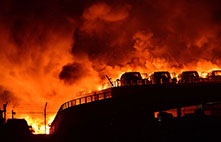A thirst for change in polluted waterways
Updated: 2016-01-29 11:25
(China Daily)
|
||||||||
The quality of China's water resources has been in decline for several decades. Now, measures are being introduced to return the country's lakes, rivers and subterranean supplies to health. Xinhua News Agency reports.
From dirty laundry to tainted wells, the strain on China's water resources is being felt nationwide after years of industrialization have left the country high and dry. Farmer Jiang Delan lived a quiet life near Bengbu city in Anhui province until an industrial park near the Sanpudagou River tainted her village's water source.
"Now the fish from the river are inedible and they stink when cooked," Jiang said. "The water quality has worsened since the establishment of the industrial park. It makes the air smell and the water in our well tastes strange."
While the village once relied on money earned from growing rice, the residents' crops are now rejected at the local market because they have an unpleasant taste.
"It does not surprise me. How can rice taste good if it is irrigated by such polluted water?" Jiang asked. "Now we only grow crops that depend less on water."
Her village is not the only one facing a crisis. Water shortages and problems related to contamination have become widespread in recent years as industrialization and urbanization take their toll.
White clothes are history
Sanxianhu township in Hunan province, named after the once pristine Sanxianhu Lake, was once famous for its abundant clear water.
But the quality began slipping toward the end of the 1970s, when industrial and agricultural wastewater was discharged directly into the lake. "Sometimes the water is black. It's impossible to drink," local resident Li Qinglan said.
Around 1980, the residents dug a well to access clean water, but other problems arose.
"At that time, girls liked to wear white dresses. But the dresses turned yellow after being washed in the tap water. White clothes soon became a rare sight in our town," Li said.
Several years later, experts discovered excessive iron and manganese content was to blame for the dirty laundry.
"The iron content in the water is 84 times higher than the national standard, and manganese is 25 times higher," said Zhao Yong, deputy head of Sanxianhu's water administration station.
In 2008, the provincial finance department funded a water-processing plant to filter the iron and manganese from the well water, but the content was still too high, making the process slow and ineffective.
In response, the villagers created their own filters by placing buckets filled with sand and cloth under their taps. "Now, everyone in the village has one," Li said.
The poor water quality has led many of the younger generation to abandon the village and seek a better life elsewhere. A new water processing plant is under construction and is expected to improve the water quality and increase supply, but many worry that it is too late.
"White clothes have already become a part of history for Sanxianhu. I'm afraid that young people will also become history," said Zhou Can, the head of a local community.
Nationwide, 27.2 percent of river water and 67.8 percent of lake water is undrinkable, according to the Ministry of Water Resources.
In 2014, when the ministry monitored 2,071 wells from 17 provincial regions in the northern part of the country, it discovered that the quality of the subterranean water was below par, meeting national standards in just 15.2 percent of the areas tested. In 48.9 percent of the areas the water was classified as "low quality", while it was designated "poor quality" in 35.9 percent.
- Students must learn safety education, experts say
- 73 bodies recovered from rubble of Shenzhen landslide
- Chinese travelers lead 2015 global outbound tourism
- S Korea to issue 10-year visa to highly-educated Chinese tourists
- A glimpse of Spring Rush: little migrant birds on the way home
- Policy puts focus on genuine artistic students
- Goodwill sets tone at Wang, Kerry's briefing
- Obama picks new Afghan commander
- Ceremony held in Auschwitz Camp to remember the Holocaust
- Thousands of beckoning cat on display in Japan's Goutoku Temple
- Chinese fishing boat capsizes off S. Korean island: Yonhap
- 42 cases of Zika infection reported in N.E. Panama

 Top 10 best selling cars on Chinese mainland 2015
Top 10 best selling cars on Chinese mainland 2015
 Warm memories in the cold winter
Warm memories in the cold winter
 The world's highest library
The world's highest library
 In-flight meal prepared for travel rush ahead of Spring Festival
In-flight meal prepared for travel rush ahead of Spring Festival
 72-year-old teaches yoga for free in Hangzhou
72-year-old teaches yoga for free in Hangzhou
 Sea ice traps boats as cold wave sweeps across East China
Sea ice traps boats as cold wave sweeps across East China
 10 tourists grab free money in one minute in East China
10 tourists grab free money in one minute in East China
 Warm colors at sunrise cast off the chill in Qingdao
Warm colors at sunrise cast off the chill in Qingdao
Most Viewed
Editor's Picks

|

|

|

|

|

|
Today's Top News
National Art Museum showing 400 puppets in new exhibition
Finest Chinese porcelains expected to fetch over $28 million
Monkey portraits by Chinese ink painting masters
Beijing's movie fans in for new experience
Obama to deliver final State of the Union speech
Shooting rampage at US social services agency leaves 14 dead
Chinese bargain hunters are changing the retail game
Chinese president arrives in Turkey for G20 summit
US Weekly

|

|









